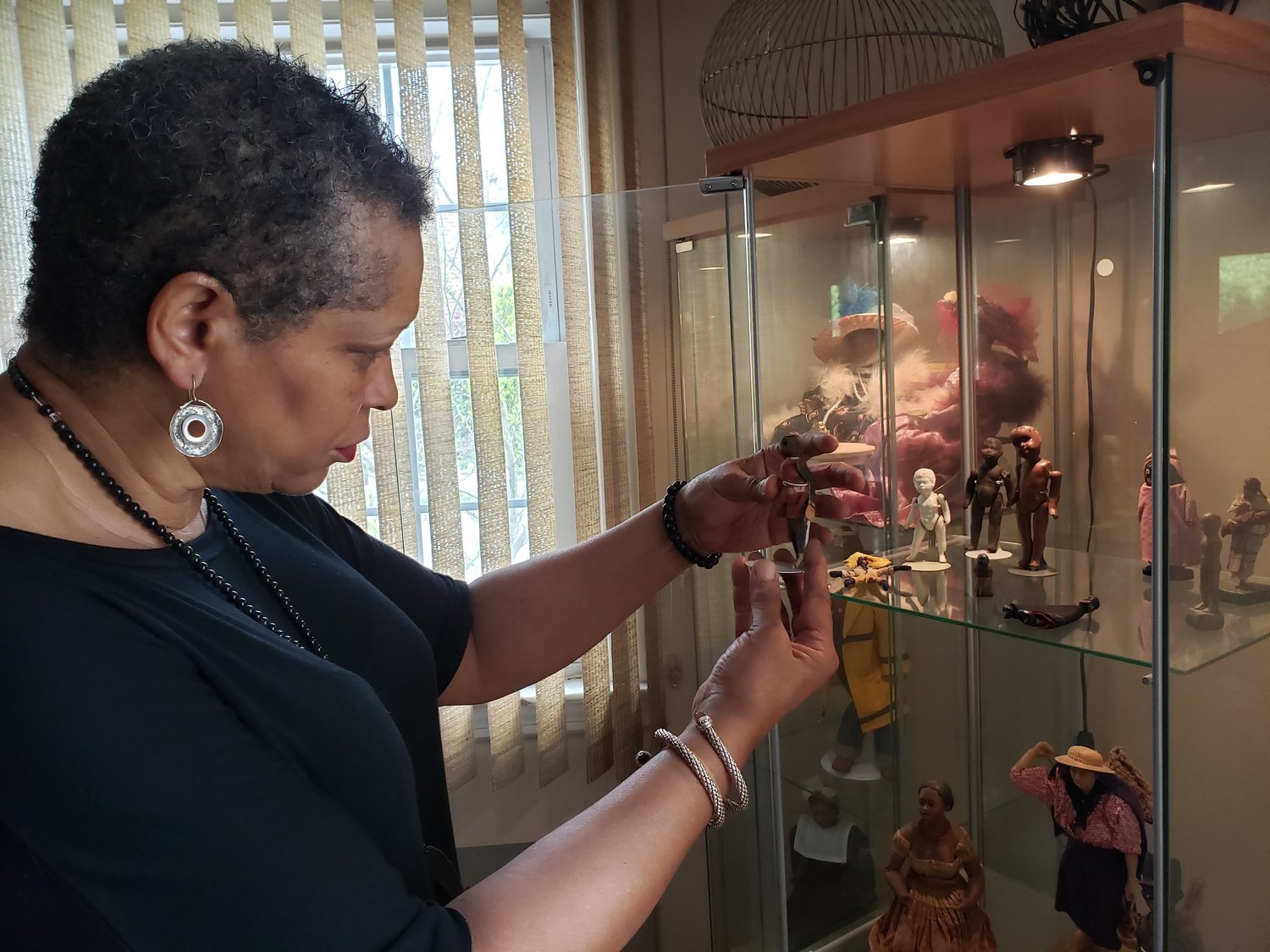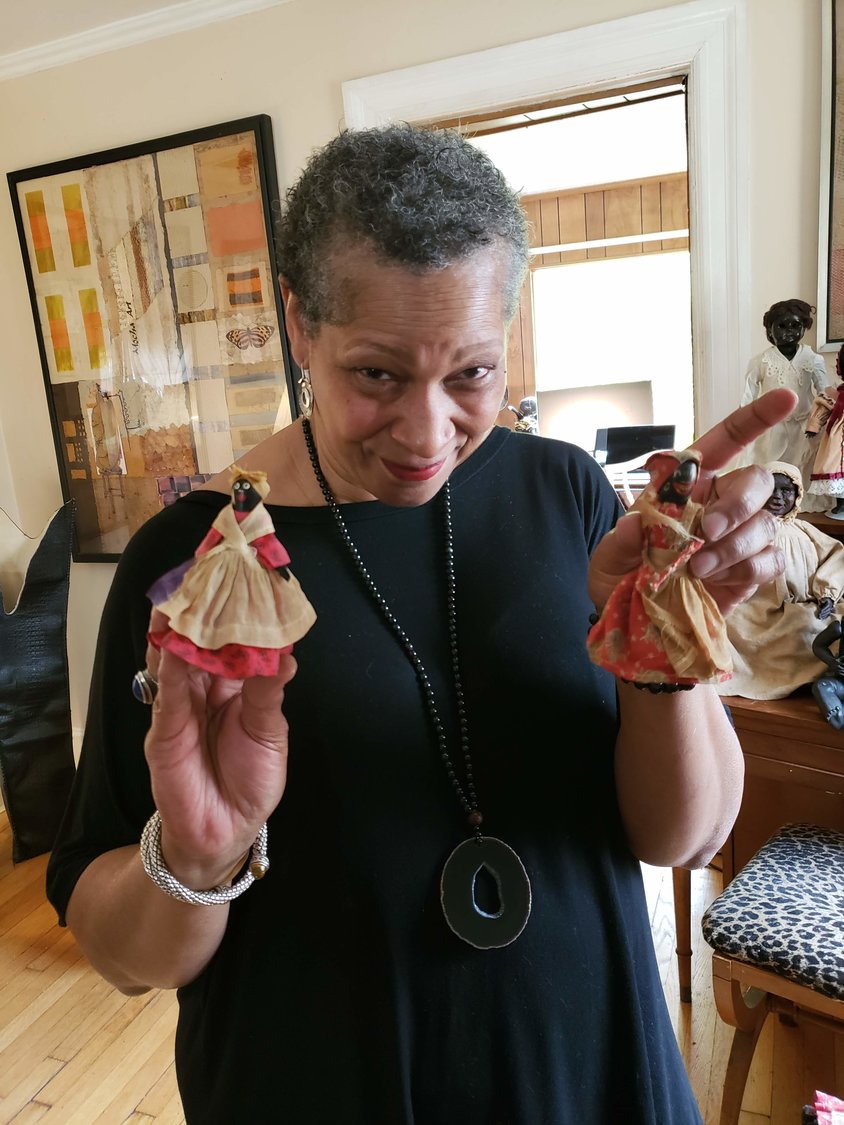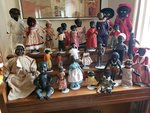Where dolls have a home
Freeporter has amassed hundreds of antique, rare collectibles
All of the dolls tell stories. Carefully lifting the red-checkered skirt of one black doll, Freeporter April Marius, 62, exposed a double-ended half of a second white doll, with hips and legs conjoined to the lower waist of the black doll.
“It’s a topsy-turvy doll,” Marius explained.
The topsy-turvy doll’s lining of one dress is the outside of the other. The skirts flip over to camouflage the body of one when the doll is upright. It’s like two dolls in one, but only one side can be played with at a time. The doll’s exact origin is uncertain, Marius said, but it first appeared in early- 19th-century plantation nurseries.
It is one piece in a collection that now boasts more than 350 rare and antique collectibles, comprising what Marius calls April’s Dollhouse.
She said she has heard stories of an unknown enslaved African-American mother making a doll for her daughter by hand. While the little black girl played with her black doll, the master saw her, and prohibited the child from playing with it. That’s when, according to Marius, the mother conjoined the doll’s lower body with a white body and told the child to flip the doll over if the master was ever near.
“These were someone’s dolls,” Marius said. “They’ve been loved on and played with.”
Originally from Fresno, Calif., Marius moved to Long Island 46 years ago. She graduated from Hempstead High School in 1974 and went on to study archeology and anthropology at Bennett College and C.W. Post, now LIU Post, in Brookville.
She worked with luxury retail brands like Bergdorf Goodman and Barney’s in New York City for almost 20 years before quitting to start her own business, A Marius Design, for which she commissioned one-of-a-kind art pieces, jewelry and handbags she crafts by hand for high-end customers.
The dolls started finding their way to her home in the late 1990s when her then 6-year-old daughter Kaylan arrived with a doll from the 1800s. Shocked to see the doll in her daughter’s possession, she asked her where it came from.
“The neighbor gave it to me,” Kayla said simply, and continued to play with it throughout the day.
Years later, Marius learned that her neighbor, whose name she did not disclose, was a doll collector. “She loved Kaylan,” Marius said, “and she just gave her the doll just because she loved her.”
Her curiosity piqued, Marius began researching her daughter’s doll and its history. One of the things she discovered was that it was very valuable.
On a trip to a doll shop in Rhode Island, she bought a few dolls, and the collection has grown since then.
“My studio is a menagerie of stuff,” Marius said. “But dolls are like anthropology. I can study the age, the texture and research these dolls.”
She has collected 362 antique dolls of color dating back to the 1800s. Some are as tiny as thimbles, made of lead and look like action figures. Others are large enough to carry around like babies.
Most of the dolls cannot be found in stores. They were handmade, played with and then put away, Marius said. They have scratches, stains and rips, evidence of a time when black dolls were not readily available to black children. Marius is particularly interested in the colored dolls because of their scarcity in the 19th century.
Some of the dolls in the collection are Latin American, Asian, Native American, European and Aboriginal. They are made of materials as diverse as porcelain, chicken bone, leather, minuette, wax, lead, iron and gloves. She even has “Our Gang,” also known as the Little Rascals, paper dolls from the 1930s. The cutouts are of Stymie, Buckwheat and Darla, and they include changes of clothes. The collection includes paper dolls from around the globe, also dating back to the 1800s, and a 2011 version of jazz songstress Josephine Baker’s paper dolls and paper dresses.
“Some of these dolls are not pretty,” Marius admitted. “But I feel that the history of all of these dolls that we’re looking is what got me interested.”
Tracking down the doll’s origins is part of the fun for Marius, who spent countless hours researching their stories. She calls them “historical puzzles.” The oldest dolls date back to 1800 and 1810, and she has contemporary dolls as well, like Daddy Long Legs from 1980s designer Karen Germain.
“These are dolls that were made by real people for their children,” she said.
The dolls are housed in her home in Sterns Park, but have been exhibited at the Nassau County African American Museum in Hempstead and the Phillips House Museum in Rockville Centre.
She is ready to bring all of them out to play. This year she decided to close A Marius Collection and took the first step to launch a nonprofit organization and open a museum where she can house the dolls permanently.
Her dream, she said, is to have a place where children and their families can visit to learn about the dolls’ history. In meantime, she will keep them stowed away until she can open the museum, with tea times and workshops.
“When people give me dolls,” Marius said, “I’m preserving the doll, but it’s the story that goes along with it.”

 47.0°,
Fair
47.0°,
Fair 









